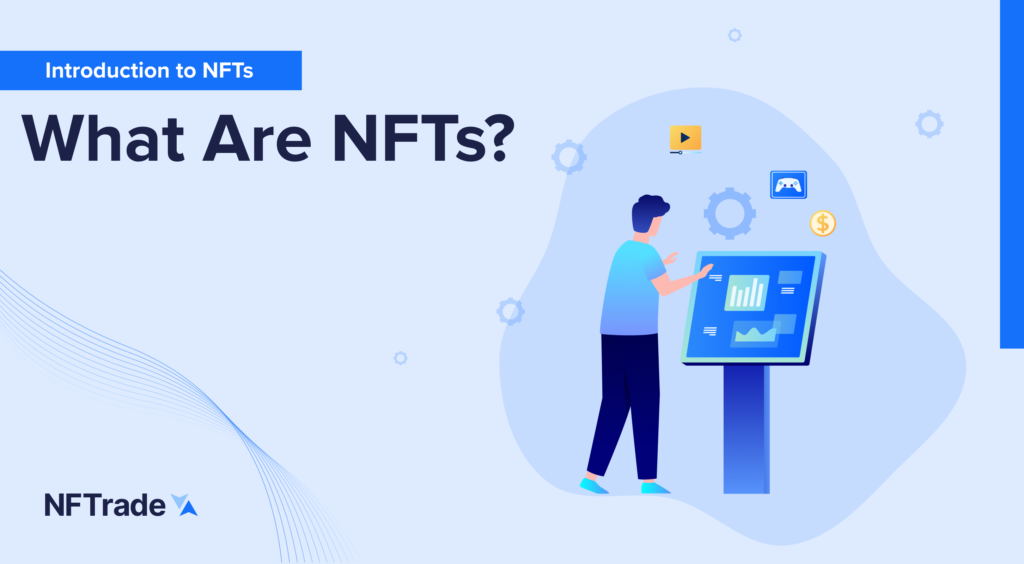Introduction to NFTs
What Are NFTs?

NFTs, or Non-Fungible Tokens, have gotten a considerable amount of press this year, and for a good reason. Some estimates put the potential market value at over $56 billion by 2030. That’s a huge valuation for a trend that started around two years ago.
But that estimate might not be far off. News headlines regularly display NFTs being purchased for thousands and even millions of dollars. So, what exactly is an NFT, and why are they worth so much?
What are Cryptocurrencies?
Before we introduce NFTs, you must first have an understanding of what cryptocurrencies are and how they operate. In simple terms, a cryptocurrency is a digital currency that is protected by cryptographic encryption, making counterfeiting and double-spending practically impossible. Cryptocurrencies are characterized by their potential immunity to control or manipulation due to the fact that they are not issued by any central authority.
Cryptocurrencies are made possible through blockchain technology. In simple terms, a blockchain is a distributed, and decentralized ledger used to complete transactions without the need for an intermediary. This database (or ledger) is distributed over a network of all the computer systems participating in the network’s validation, meaning there is no single point of control or failure. Transactions on the blockchain are controlled and confirmed by a decentralized network of computers, as opposed to a single central system.

Bitcoin is the first and most popular cryptocurrency, created in 2008 by an anonymous entity known only as Satoshi Nakamoto. Aside from Bitcoin, there are a variety of cryptocurrencies available on the market. There’s Ether, the native token of the Ethereum blockchain and the second-largest cryptocurrency market. BNB, Cardano, XRP, Tether, USD Coin, and Solana are among some of the other popular available cryptocurrencies.
What Does Non-Fungible Mean?
Items or commodities that are fungible can be exchanged for other assets or commodities of the same type without losing any inherent value. For example, all types of currencies, including cryptocurrencies, are fungible assets since they can be traded for other identical assets without losing any value in the transaction. If you exchange a $1 bill for a totally different $1 bill, no value has been lost on the transaction.

On the other hand, non-fungible items cannot be intermittently traded, as they are all inherently unique. Because of their distinct characteristics, art and collectible digital tokens are non-fungible, as even identical art pieces can fetch different prices and values depending on other characteristics, such as their creation or ownership history. Because there is only one original of each NFT, it has a unique quality that cannot be simply traded for something of identical value, as each asset can be valued separately from others. For example, if an edition of 50 identical NFTs was made by a famous artist, the 1st copy may be more valuable than the 39th since it has the prestige of being the first to hit the market.
What are NFTs, and what can they be used for?
NFT is an acronym for a non-fungible token, verifiably unique cryptographic assets stored on the blockchain. These tokens include unique identification codes and metadata that identify them from one another. They cannot be traded or exchanged for equivalency, unlike most cryptocurrencies. This is in contrast to fungible tokens, such as traditional currencies, which are identical to one another, and hence, can be used as a means of exchange.
Most NFTs are created on the Ethereum blockchain but have started to broaden their reach to other networks like Solana, Binance Smart Chain, and Avalanche. Examples of digital items that can be turned into NFTs include gaming items, artworks, digital music, tickets, digital receipts, music, videos, and more.

Each NFT has a unique construction that can be applied in a variety of ways. They’re a great way to represent tangible items like real estate and artwork digitally, for example. NFTs can also be used to eliminate intermediaries and link artists with audiences or to verify authenticity because they are created on an immutable ledger – a blockchain network.
As the underlying technology and concept improve, NFTs could have a wide range of applications outside of just the art world. A school, for example, could issue NFTs as degrees to students, allowing employers to promptly validate the educational qualifications of their applicants. Alternatively, venues could reduce ticket resale fraud by selling and tracking event tickets via NFTs.
Why would someone create or own an NFT?
The main benefit of NFT technology is the ability to offer verifiable unique digital ownership for the first time. NFTs also limit ownership to the artist and prevent duplication by providing a channel through which actual objects, such as art pieces, can be tokenized. This makes the artwork rare and, as such, potentially more valuable.
Furthermore, investors have more control over their assets if the assets have been tokenized. A virtual landowner could choose to put his or her virtual property up for rent to advertisers for a fee without losing ownership of the land. The virtual representation of the land still belongs to the owner in this case, but a portion of it has been liquidated for rent.
Key Takeaways
Even though the same blockchain technology underpins both NFTs and traditional cryptocurrencies, there are a lot of inherent differences between both token iterations. Cryptocurrencies are designed to function as currencies by holding and storing value, allowing you to buy and sell items. Cryptocurrency tokens are fungible, like fiat currencies such as the dollar or Euro. NFTs, on the other hand, create one-of-a-kind tokens that can be used to demonstrate ownership and transfer rights to digital assets. The applications of these tokens can completely revolutionize entire industries like art, real estate, gaming, and more.









